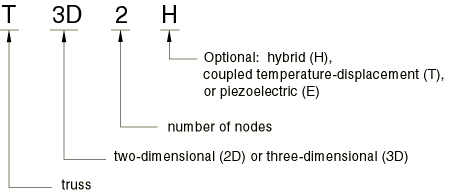Typical Applications
Truss elements are used in two and three dimensions to model slender, line-like structures that support loading only along the axis or the centerline of the element. No moments or forces perpendicular to the centerline are supported.
The two-dimensional truss elements can be used in axisymmetric models to represent components, such as bolts or connectors, where the strain is computed from the change in length in the r–z plane only. Two-dimensional trusses can also be used to define main surfaces for contact applications in Abaqus/Standard (see About Contact Interactions). In this case the direction of the main surface's outward normal is critical for proper detection of contact.
The 3-node truss element available in Abaqus/Standard is often useful for modeling curved reinforcing cables in structures, such as prestressed tendons in reinforced concrete or long slender pipelines used in the off-shore industry.

